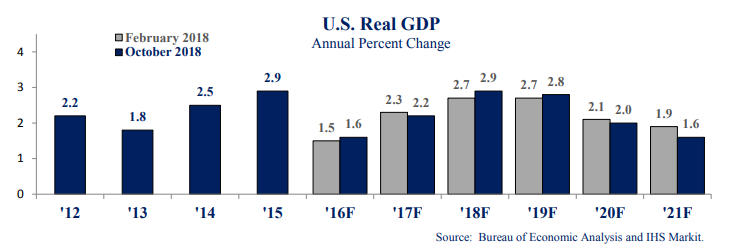The recently released October Revenue and Economic Update gave us mixed news about the state’s economic and budget landscape. The quarterly report from Minnesota Management and Budget (MMB) showed that the state revenues have come in higher than anticipated. It also reports that the national economy is expected to grow in the near term, but then that growth will taper off over the next few years.
Some of the top takeaways from the Update include:
1. State revenues for the most recent quarter came in above projections. The state’s revenues for July to September came in $282 million above projections; that’s 5.9 percent more than projected in the state’s February 2018 Economic Forecast. The increase is a result of a variety of factors, including higher income and corporate taxes received, as well as a higher than expected surplus in a state workers’ compensation fund.
2. State revenues for the past fiscal year came in slightly above projections. The state’s revenues for FY 2018, which ended on June 30, came in $376 million above projections, or 1.7 more than was projected in the February forecast.
3. Long-term economic growth is expected to be lower. The national economic forecasters predict stronger national GDP growth for 2018. The October update predicts 2.9 percent growth in 2018, up from the 2.7 percent predicted in February. In 2019, growth is projected to be 2.8 percent, very similar to the 2.7 percent anticipated in February. However, growth is then expected to slow to 1.6 percent by 2021. The slower growth in 2020 and beyond is due to several factors, including the effects of the new tariffs between the U.S. and China.

4. National unemployment rate expected to remain low. Nationally, unemployment was 3.7 percent in September, and is expected to drop to 3.5 percent on average in 2019. Job growth has slowed slightly, with the economy adding around 134,000 jobs in September, compared to the average of 200,000 jobs per month earlier this year. This slowdown is expected to be a temporary effect of Hurricane Florence, which hit the Southeast coast in September.
5. Forecasters are fairly confident in their projections. The forecasters assign a 60 percent chance that their baseline forecast is correct. They also give a 25 percent chance for a more pessimistic scenario in which there’s a recession starting next year, and assign a 15 percent probability to a more optimistic scenario.
The next legislative session starts in just a few months, and policymakers will need to put together the state’s next two-year budget. In early December, we’ll see the state’s November Budget and Economic Forecast, which will give us an updated and more complete picture of what resources will be available as policymakers and the public engage in next year’s budget debate.
After the conclusion of this past legislative session, we estimated that the state could expect a surplus of about $300 million for FY 2020-21. The increased revenues measured in this week’s economic update suggest that number could get larger by the time the November economic forecast comes out. However, the lower expected economic growth in the longer term could also dampen future revenues.
-Clark Goldenrod